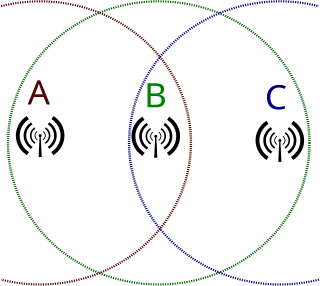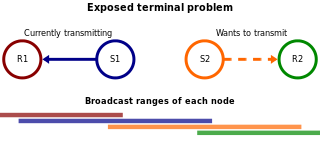
IEEE 802.11 is part of the IEEE 802 set of local area network (LAN) technical standards, and specifies the set of medium access control (MAC) and physical layer (PHY) protocols for implementing wireless local area network (WLAN) computer communication. The standard and amendments provide the basis for wireless network products using the Wi-Fi brand and are the world's most widely used wireless computer networking standards. IEEE 802.11 is used in most home and office networks to allow laptops, printers, smartphones, and other devices to communicate with each other and access the Internet without connecting wires. IEEE 802.11 is also a basis for vehicle-based communication networks with IEEE 802.11p.
Carrier-sense multiple access with collision detection (CSMA/CD) is a medium access control (MAC) method used most notably in early Ethernet technology for local area networking. It uses carrier-sensing to defer transmissions until no other stations are transmitting. This is used in combination with collision detection in which a transmitting station detects collisions by sensing transmissions from other stations while it is transmitting a frame. When this collision condition is detected, the station stops transmitting that frame, transmits a jam signal, and then waits for a random time interval before trying to resend the frame.
Carrier-sense multiple access (CSMA) is a medium access control (MAC) protocol in which a node verifies the absence of other traffic before transmitting on a shared transmission medium, such as an electrical bus or a band of the electromagnetic spectrum.

Wi-Fi is a family of wireless network protocols based on the IEEE 802.11 family of standards, which are commonly used for local area networking of devices and Internet access, allowing nearby digital devices to exchange data by radio waves. These are the most widely used computer networks, used globally in home and small office networks to link devices and to provide Internet access with wireless routers and wireless access points in public places such as coffee shops, hotels, libraries, and airports to provide visitors.
In telecommunications and computer networks, a channel access method or multiple access method allows more than two terminals connected to the same transmission medium to transmit over it and to share its capacity. Examples of shared physical media are wireless networks, bus networks, ring networks and point-to-point links operating in half-duplex mode.
ALOHAnet, also known as the ALOHA System, or simply ALOHA, was a pioneering computer networking system developed at the University of Hawaii.
A collision domain is a network segment connected by a shared medium or through repeaters where simultaneous data transmissions collide with one another. The collision domain applies particularly in wireless networks, but also affected early versions of Ethernet. A network collision occurs when more than one device attempts to send a packet on a network segment at the same time. Members of a collision domain may be involved in collisions with one another. Devices outside the collision domain do not have collisions with those inside.
IEEE 802.11e-2005 or 802.11e is an approved amendment to the IEEE 802.11 standard that defines a set of quality of service (QoS) enhancements for wireless LAN applications through modifications to the media access control (MAC) layer. The standard is considered of critical importance for delay-sensitive applications, such as voice over wireless LAN and streaming multimedia. The amendment has been incorporated into the published IEEE 802.11-2007 standard.
Distributed coordination function (DCF) is the fundamental medium access control (MAC) technique of the IEEE 802.11-based WLAN standard. DCF employs a carrier-sense multiple access with collision avoidance (CSMA/CA) with the binary exponential backoff algorithm.

In wireless networking, the hidden node problem or hidden terminal problem occurs when a node can communicate with a wireless access point (AP), but cannot directly communicate with other nodes that are communicating with that AP. This leads to difficulties in medium access control sublayer since multiple nodes can send data packets to the AP simultaneously, which creates interference at the AP resulting in no packet getting through.
IEEE 802.15.4 is a technical standard which defines the operation of a low-rate wireless personal area network (LR-WPAN). It specifies the physical layer and media access control for LR-WPANs, and is maintained by the IEEE 802.15 working group, which defined the standard in 2003. It is the basis for the Zigbee, ISA100.11a, WirelessHART, MiWi, 6LoWPAN, Thread, Matter and SNAP specifications, each of which further extends the standard by developing the upper layers which are not defined in IEEE 802.15.4. In particular, 6LoWPAN defines a binding for the IPv6 version of the Internet Protocol (IP) over WPANs, and is itself used by upper layers like Thread.
RTS/CTS is the optional mechanism used by the 802.11 wireless networking protocol to reduce frame collisions introduced by the hidden node problem. Originally the protocol fixed the exposed node problem as well, but modern RTS/CTS includes ACKs and does not solve the exposed node problem.

In wireless networks, the exposed node problem occurs when a node is prevented from sending packets to other nodes because of co-channel interference with a neighboring transmitter. Consider an example of four nodes labeled R1, S1, S2, and R2, where the two receivers are out of range of each other, yet the two transmitters in the middle are in range of each other. Here, if a transmission between S1 and R1 is taking place, node S2 is prevented from transmitting to R2 as it concludes after carrier sense that it will interfere with the transmission by its neighbor S1. However note that R2 could still receive the transmission of S2 without interference because it is out of range of S1.
In computer networking, carrier-sense multiple access with collision avoidance and resolution using priorities (CSMA/CARP) is a channel access method. CSMA/CARP is similar in nature to the carrier-sense multiple access with collision detection (CSMA/CD) channel access method used in Ethernet networks, but CSMA/CARP provides no detection of network collisions. Instead of detecting network collisions, CSMA/CARP attempts to avoid collisions by using a system of transmission priorities.
Multiple Access with Collision Avoidance (MACA) is a slotted media access control protocol used in wireless LAN data transmission to avoid collisions caused by the hidden station problem and to simplify exposed station problem.
Multiple Access with Collision Avoidance for Wireless (MACAW) is a slotted medium access control (MAC) protocol widely used in ad hoc networks. Furthermore, it is the foundation of many other MAC protocols used in wireless sensor networks (WSN). The IEEE 802.11 RTS/CTS mechanism is adopted from this protocol. It uses RTS-CTS-DS-DATA-ACK frame sequence for transferring data, sometimes preceded by an RTS-RRTS frame sequence, in view to provide solution to the hidden node problem. Although protocols based on MACAW, such as S-MAC, use carrier sense in addition to the RTS/CTS mechanism, MACAW does not make use of carrier sense.
IEEE 802.11g-2003 or 802.11g is an amendment to the IEEE 802.11 specification that operates in the 2.4 GHz microwave band. The standard has extended link rate to up to 54 Mbit/s using the same 20 MHz bandwidth as 802.11b uses to achieve 11 Mbit/s. This specification, under the marketing name of Wi‑Fi, has been implemented all over the world. The 802.11g protocol is now Clause 19 of the published IEEE 802.11-2007 standard, and Clause 19 of the published IEEE 802.11-2012 standard.

Mobile Slotted Aloha (MS-Aloha) is a wireless network protocol proposed for applications such as vehicle networks.
Traffic indication map (TIM) is a structure used in 802.11 wireless network management frames.

An evolved wireless ad hoc network (EVAN) is a decentralized type of wireless network that compensates for the shortcomings of the existing wireless ad hoc network (WANET). An EVAN is ad hoc like a WANET because it does not rely on a pre-existing infrastructure, such as routers in wired networks or access points in wireless networks. Further advantages of WANETs over networks with a fixed topology include flexibility, scalability and lower administration costs. These characteristics of WANETs are maintained in EVAN as well. However, an EVAN has a physically separate resource management channel called tone channel, unlike existing WANETs. In WANETs, the data channel performs two roles: resource management and data transfer, but in EVAN, the data channel is used only for data transfer.






